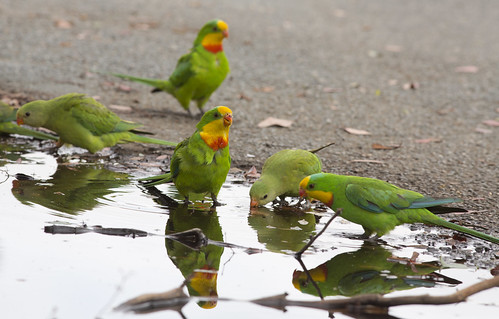 Superb parrots hanging around in a Belconnen carpark. The threatened birds are breeding again in the ACT and region, but could be removed from Commonwealth legislation as a threatened species. Image by LizardstompA proposal to downgrade protection of the superb parrot will undo years of conservation work, say Canberra environmentalists.
Superb parrots hanging around in a Belconnen carpark. The threatened birds are breeding again in the ACT and region, but could be removed from Commonwealth legislation as a threatened species. Image by LizardstompA proposal to downgrade protection of the superb parrot will undo years of conservation work, say Canberra environmentalists.
Listed as threatened under Commonwealth legislation, the long-tailed green parrot with a splash of yellow and orange across its throat started breeding again in Canberra's north about eight years ago, and is seen in growing numbers around Belconnen.
As a threatened species superb parrots have helped changed the development landscape around Canberra.
The National Capital Authority excised 560 hectares from Central Molonglo's residential redevelopment to protect woodlands habitat for endangered species including.
The number of planned new homes at Throsby was halved in 2012 and in 2011 Roads and Maritime Services removed and replanted hollow bearing trees to protect the parrots' habitat while straightening the Barton Highway.
The Action Plan for Australian Birds 2000, which estimated only about 6500 adult birds survived and were in decline was reassessed in 2010 and concluded the number of superb parrots was substantially greater than 10,000 and likely stable. A key part of that finding has been the parrot's breeding in Canberra's north over an area from which they almost disappeared in the late 1960s.
But scientists and bird watchers believe downgrading the listing under the Environment Protection and Biodiversity Conservation Act lacks sufficient data, and will not only set back the superb parrot's cause, but that of other native animals which live in the same habitat, hollow logs in century old gum trees.
Retired CSIRO scientist and long serving Canberra Ornithologists Group member Chris Davey says Central Molonglo and Throsby supported breeding pairs. "I think this is the reason we get so many superb parrots in the Belconnen area and Gungahlin, rather than southern Canberra where they are really unusual."
Mr Davey said seeing more birds about did not necessarily mean an increase in numbers. It may indicate their distribution had changed because of climate change, or other factors.
"What we can't do is assume that because the distribution has increased, they are more frequently seen and breeding in the ACT, that this is a result of increased numbers," he said.
A team leader on threatened species in the south east region for the Office of Environment and Heritage, Dr Damon Oliver, believes the threatened listing must remain.
Dr Oliver has been working with associate professor Adrian Manning of the ANU's Fenner School and 30 community volunteers, mostly farmers, monitoring superb parrots around Boorowa, Yass and Young regions. They have compared their surveys from 2013 and 2014 with Dr Manning's Phd research on superb parrots in 2000.
They found a "worrying decline" in numbers. "We have not seen any evidence to support de-listing, we think there is compelling evidence numbers may still be declining," Dr Oliver said.
Their findings will be presented in a submission which will also include independent research from scientists from the Office of Environment and Heritage who found a 50 per cent decline in superb parrots in an area west of Dubbo over eight years.
Dr Oliver said while some farmers had protected old trees and planted supporting habitat for the birds, people in rural areas were seeing more losses of large old trees with hollows.
The ACT Conservation Council says among other things, taking the superb parrot off the threatened list will greatly undermine all of the work on tree protection in rural areas and could affect funding available for tree planting.
The council is urging more people to make submissions to the Department of Environment's wildlife, heritage and marine division before January 9, 2015.